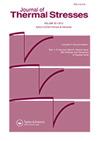Surface-to-Volume Ratio Affects the Toxicity of Nanoinks in Daphnids
IF 2.3
3区 工程技术
Q2 MECHANICS
引用次数: 0
Abstract
The Organization for Economic Co-operation and Development (OECD) has set widely used guidelines that are used as a standardized approach for assessing toxicity in a number of species. Given that various studies use different experimental setups, it is difficult to compare findings across them as a result of the lack of a universally used setup in nano-ecotoxicology. For freshwater species, Daphnia magna, a commonly used filter feeding crustacean, can generate significant molecular information in response to pollutant exposure. One factor that has an effect in toxicity induced from nanomaterials in daphnids is the surface-to-volume ratio of the exposure vessels; however, there is limited information available about its impact on the observed effect of exposure. In this study, daphnids were exposed to silver nanoparticle ink in falcon tubes and Petri dishes for 24 h. Toxicity curves revealed differences in the observed mortality of daphnids, with animals exposed in Petri dishes displaying significantly higher mortality. Differences in the activities of a number of key enzymes involved in the catabolism of macromolecules and phosphate were also observed across the exposure setups, indicating possible differences in the toxicity mechanism of silver nano-ink. Understanding the impact of factors relevant to experimental setups in ecotoxicology can increase the reproducibility of testing, and also reduce experimental costs, time, generated waste, and daphnids used in research.表面体积比影响纳米油墨对水蚤的毒性
经济合作与发展组织(经合组织)制定了广泛使用的指导方针,作为评估若干物种毒性的标准化方法。鉴于各种研究使用不同的实验装置,由于缺乏纳米生态毒理学中普遍使用的装置,很难对它们之间的发现进行比较。对于淡水物种来说,大水蚤是一种常用的滤食性甲壳类动物,它可以对污染物暴露产生重要的分子信息。纳米材料在水蚤中引起毒性的一个影响因素是暴露容器的表面体积比;然而,关于它对观察到的暴露效应的影响,现有的信息有限。在本研究中,水蚤在隼管和培养皿中暴露于纳米银墨水24小时。毒性曲线显示了观察到的水蚤死亡率的差异,培养皿中暴露的动物死亡率明显更高。在不同的暴露条件下,参与大分子和磷酸盐分解代谢的一些关键酶的活性也存在差异,这表明银纳米油墨的毒性机制可能存在差异。了解生态毒理学中与实验设置相关的因素的影响可以增加测试的可重复性,也可以减少实验成本、时间、产生的废物和研究中使用的水蚤。
本文章由计算机程序翻译,如有差异,请以英文原文为准。
求助全文
约1分钟内获得全文
求助全文
来源期刊

Journal of Thermal Stresses
工程技术-力学
CiteScore
5.20
自引率
7.10%
发文量
58
审稿时长
3 months
期刊介绍:
The first international journal devoted exclusively to the subject, Journal of Thermal Stresses publishes refereed articles on the theoretical and industrial applications of thermal stresses. Intended as a forum for those engaged in analytic as well as experimental research, this monthly journal includes papers on mathematical and practical applications. Emphasis is placed on new developments in thermoelasticity, thermoplasticity, and theory and applications of thermal stresses. Papers on experimental methods and on numerical methods, including finite element methods, are also published.
 求助内容:
求助内容: 应助结果提醒方式:
应助结果提醒方式:


